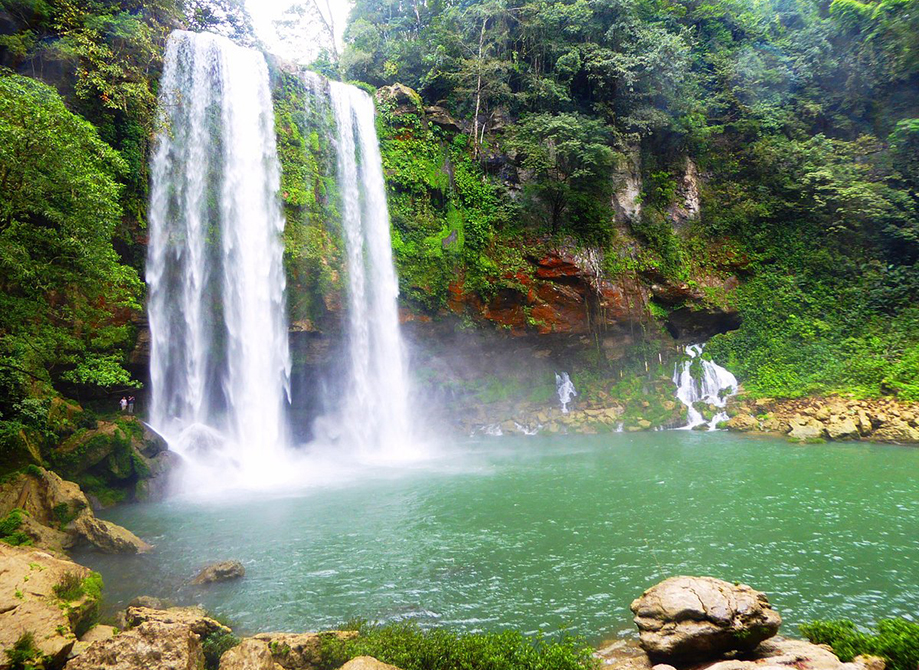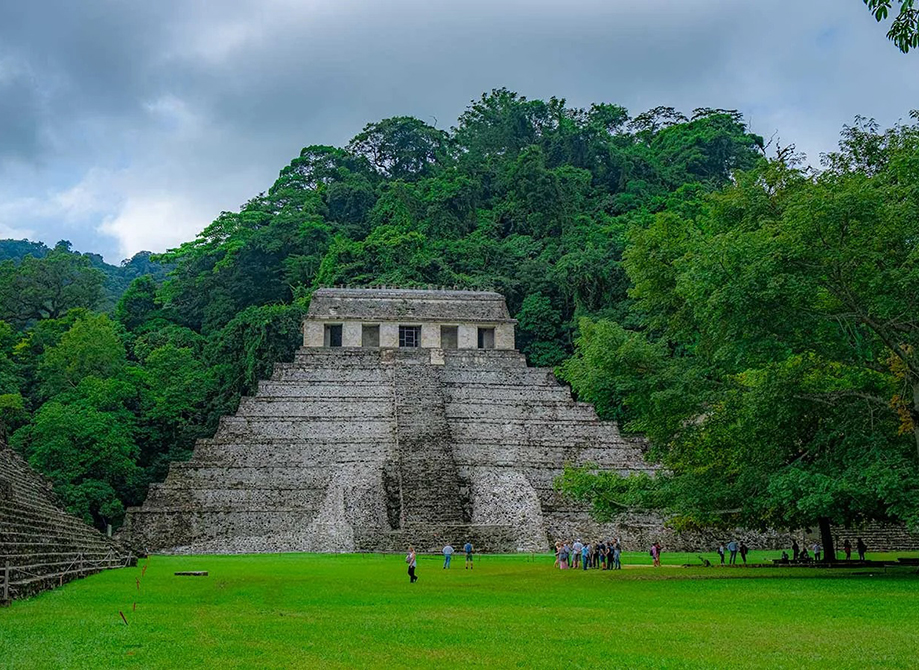I have always been drawn to mysterious ancient sites, and Palenque in Mexico is undoubtedly one of the most captivating. Located in the southern state of Chiapas, Palenque is a jewel of the Mayan civilization, renowned for its stunning pyramids and enigmatic history. After experiencing the magic of Palenque firsthand, I couldn’t wait to share this unforgettable journey with you. Join me as I dive into the secrets of the Kingdom of the Red Queen, and offer practical tips for making the most of your visit to this incredible archaeological site.
1. Palenque: One of Mexico’s Most Beautiful Mayan Pyramids
Palenque is a truly mesmerizing ancient Mayan city that captivates visitors with its well-preserved ruins, deep historical significance, and the lush, verdant jungle that surrounds it. Nestled in the state of Chiapas, Palenque is not as vast as some of the other Mayan cities, like Tikal or Chichen Itza, but what it lacks in size, it more than makes up for in the richness of its architecture and the stories etched into its stones.
The Temple of the Inscriptions: A Monument to Mayan Majesty
The Temple of the Inscriptions is arguably the most iconic structure in Palenque. This grand pyramid, standing at over 22 meters high, dominates the landscape and serves as a poignant reminder of the power and artistry of the ancient Maya. The pyramid is named after the intricate inscriptions found within it, which are some of the most important sources of information about the Mayan civilization.
Upon arriving at the temple, I was immediately struck by its imposing presence. The steep, stepped facade, characteristic of Mayan pyramids, seemed to beckon me upwards, as if inviting me to uncover the secrets of this ancient world. Each step felt like a journey back in time, with the dense jungle surrounding the pyramid adding a sense of mystery and seclusion.
Inside the Temple of the Inscriptions lies the tomb of K’inich Janaab’ Pakal, better known as Pakal the Great, one of the most significant rulers of Palenque. Pakal’s reign marked a period of prosperity and architectural innovation, and his legacy is deeply woven into the fabric of Palenque’s history. The tomb itself is a masterpiece of Mayan funerary art, featuring a sarcophagus lid carved with intricate designs that depict Pakal’s journey to the afterlife.
As I stood at the top of the pyramid, I took a moment to absorb the breathtaking view. The surrounding jungle stretches out as far as the eye can see, with the other ruins of Palenque peeking through the dense foliage. The connection to the past felt palpable, as if the spirits of the Maya were still watching over their once-great city.
The Temple of the Red Queen: Unraveling a Royal Mystery
Not far from the Temple of the Inscriptions lies another fascinating structure—the Temple of the Red Queen. This smaller, yet equally intriguing, pyramid is shrouded in mystery and intrigue, largely due to the discovery of a royal tomb within it, believed to belong to a Mayan queen, possibly Pakal’s wife or another royal female figure.
The discovery of the Red Queen’s tomb was a significant archaeological find, not only because of its contents but also because it provided new insights into the role of women in Mayan society. The tomb was adorned with precious items, including jade jewelry, intricate masks, and richly colored ceramics, all of which underscored the high status of the individual buried within.
One of the most striking aspects of the tomb was the presence of red cinnabar powder that covered the skeletal remains, giving the tomb its name—the Temple of the Red Queen. Cinnabar was a substance associated with royalty and the afterlife, and its use in the tomb emphasized the queen’s importance in both life and death.
Walking through the temple and the surrounding area, I felt a deep sense of reverence. The Red Queen’s tomb is a poignant reminder of the often overlooked contributions of women in ancient civilizations. The murals and artifacts found within the temple tell a story of a powerful woman who played a crucial role in the cultural and political life of Palenque.
The temple’s location, nestled within the jungle and surrounded by the sounds of nature, added to its mystical atmosphere. As I explored the site, I couldn’t help but imagine the ceremonies and rituals that might have taken place here, honoring the queen and ensuring her passage to the afterlife.
The Palace: A Center of Power and Artistry
The Palace of Palenque is another architectural marvel that left a lasting impression on me. Unlike the towering pyramids, the Palace is a sprawling complex of interconnected buildings, courtyards, and corridors, serving as the administrative and residential heart of the city. The Palace is renowned for its intricate stucco carvings, which depict scenes from Mayan mythology, daily life, and the exploits of Pakal the Great.

Walking through the Palace, I was struck by the ingenuity of its design. The structure is built on multiple levels, with narrow staircases, hidden passageways, and open courtyards that create a sense of both grandeur and intimacy. The Tower, a four-story structure within the Palace, offered stunning views of the surrounding ruins and the jungle beyond. It was easy to imagine the rulers of Palenque standing here, surveying their city and planning its future.
One of the most fascinating aspects of the Palace is the aqueduct system that runs beneath it. The Maya were skilled engineers, and this system channeled water from nearby streams into the Palace, providing a constant supply of fresh water. The ingenuity and sophistication of Mayan engineering are on full display here, making the Palace not just a symbol of power, but also of the advanced knowledge possessed by this civilization.
Exploring Palenque’s ruins, I was constantly reminded of the incredible legacy left behind by the Maya. Each structure, from the grand pyramids to the more modest residential areas, tells a story of a civilization that was deeply connected to its environment, its gods, and its people. The beauty of Palenque lies not just in its physical structures, but in the stories they hold and the mysteries that continue to intrigue and inspire us today.
2. Practical Information for Visiting Palenque Ruins
Best Time to Visit: The ideal time to visit Palenque is between November and April when the weather is drier and more comfortable for exploring. Avoid the rainy season, as the paths can become slippery and the heat can be intense, making it difficult to fully enjoy the ruins.
Tickets and Opening Hours: The entrance fee to the Palenque ruins is around 60 Mexican pesos (approximately $3 USD), and the site is open daily from 8 AM to 5 PM. I recommend arriving early in the morning to beat the crowds and enjoy the serene atmosphere before the day gets too hot.
Guided Tours: To truly appreciate the history and significance of Palenque, I highly recommend hiring a professional guide. A knowledgeable guide can bring the site to life with stories and insights into Mayan culture, making your visit much more enriching. Guide fees usually range from 500 to 1000 Mexican pesos (about $25 to $50 USD), depending on the service and the guide’s expertise.
What to Wear and Bring: The terrain at Palenque can be uneven and steep, so comfortable hiking shoes are essential. Don’t forget to pack sunscreen, a hat, and sunglasses to protect yourself from the sun. Carry plenty of water to stay hydrated, and consider bringing a light rain jacket in case of sudden weather changes.
3. The Magnificent Misol-Ha Waterfall
After exploring the Palenque ruins, I ventured to the nearby Misol-Ha Waterfall, a spectacular natural attraction. The waterfall stands at about 35 meters (115 feet) high, with water cascading over the cliffs into a serene pool below. Surrounded by lush tropical vegetation, Misol-Ha is a picture-perfect spot for nature lovers and photographers alike.

Practical Tips: To fully enjoy your time at Misol-Ha, I recommend wearing swimwear or clothes suitable for getting wet, as you can walk behind the waterfall and feel the refreshing spray. Be sure to bring waterproof bags for your electronics and valuables. There are also small trails around the waterfall, offering excellent opportunities for scenic photos. Near the waterfall, you’ll find a few local eateries where you can grab a quick bite and souvenir shops selling handcrafted goods.
4. Practical Tips for Exploring Palenque
Getting There: From major cities like Mexico City, you can fly into Villahermosa or Palenque Airport, then take a taxi or rent a car to reach the ruins. If you’re planning a road trip, make sure your vehicle is suitable for the winding and sometimes rugged roads leading to Palenque.
Where to Stay: There are many comfortable hotels and lodges around Palenque that cater to various budgets. I chose to stay in a hotel close to the ruins for easy access in the morning. Look for accommodations that offer convenient transportation services and relaxing environments to enhance your stay.
Food Recommendations: Around Palenque, you’ll find plenty of local eateries and street food vendors serving authentic Mexican cuisine. Be sure to try regional specialties like tacos, carne asada, and tortillas. These dishes are not only delicious but also give you a deeper connection to the local culture.
Palenque is not only a treasure trove of Mayan history but also a destination filled with natural beauty and cultural richness. From the awe-inspiring pyramids to the majestic Misol-Ha waterfall, every corner of this region offers something unique and unforgettable. I hope this guide helps you plan your trip to Palenque and provides the practical advice you need to make your visit as smooth and enjoyable as possible.
